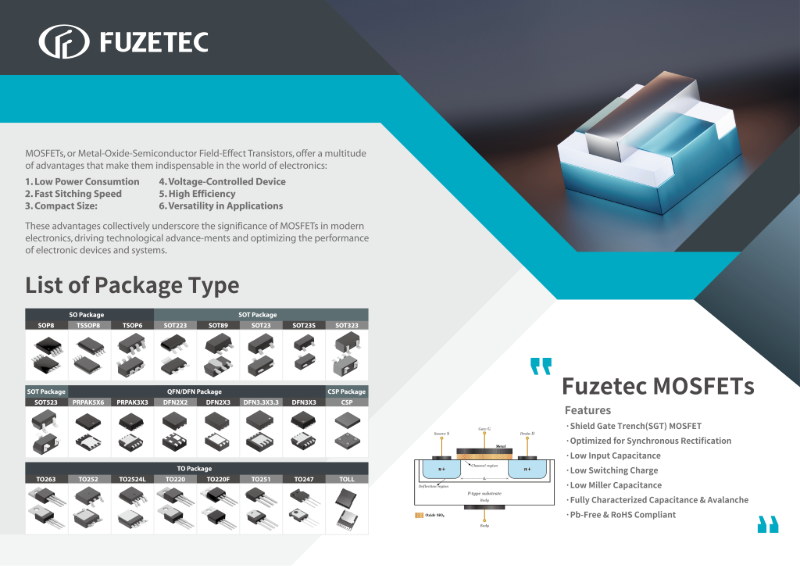Introduction
In the ever-evolving landscape of electronics, the Metal-Oxide-Semiconductor Field-Effect Transistor (MOSFET) plays a pivotal role in numerous applications. From power management in consumer electronics to automotive systems, MOSFETs are integral components that ensure efficient performance. One critical aspect of MOSFET functionality is its packaging type, which can significantly impact its thermal performance, reliability, and suitability for specific applications. This article aims to provide a detailed overview of various MOSFET packaging types and offer guidance on selecting the appropriate package for your application.
Understanding MOSFET Packaging
What is MOSFET Packaging?
MOSFET packaging refers to the physical casing that houses the MOSFET chip, providing mechanical support and protection while enabling electrical connectivity to the circuit. The packaging type affects the MOSFET's heat dissipation, size, and ease of mounting, all of which are crucial factors in its performance and reliability.
Importance of MOSFET Packaging
Choosing the right MOSFET packaging is essential for several reasons:
- Thermal Management:Efficient heat dissipation is vital to prevent overheating and ensure the longevity of the MOSFET.
- Space Constraints:Compact packaging is necessary for applications with limited space.
- Electrical Performance:Packaging impacts the MOSFET's parasitic inductance and resistance, affecting its overall electrical performance.
- Mounting and Handling:Different packaging types offer various mounting options, influencing the ease of assembly and reliability of the connections.
Fuzetec MOSFET Package Information

Common MOSFET Packaging Types
Through-Hole Packages
TO-220
The TO-220 package is a popular choice for power MOSFETs due to its excellent thermal performance and ease of mounting. It features a metal tab for heat sinking and is suitable for applications requiring efficient heat dissipation.
- Advantages:High power dissipation, robust mechanical design.
- Disadvantages:Larger footprint, not suitable for high-density applications.
TO-247
The TO-247 package is designed for higher power applications than the TO-220. It provides even better thermal performance and can handle higher currents, making it ideal for industrial and automotive applications.
- Advantages:Superior thermal management, high current capability.
- Disadvantages:Larger size, more challenging to handle in compact designs.
Surface-Mount Packages
TO-252 (DPAK)
DPAK, also known as TO-252, is a surface-mount package that offers a good balance between thermal performance and compact size. It is widely used in power management applications.
- Advantages:Good thermal performance, compact size.
- Disadvantages:Moderate current handling, requires careful soldering.
TO-263 (D2PAK)
The TO-263, or D2PAK, is a larger surface-mount package compared to DPAK. It provides better thermal performance and can handle higher currents, making it suitable for more demanding applications.
- Advantages:High power dissipation, robust design.
- Disadvantages:Larger footprint, higher cost.
SO/SOIC Package
The SO/SOIC package is a small-outline package commonly used for low-power MOSFETs in space-constrained applications. It offers moderate thermal performance and is suitable for switching and signal applications.
- Advantages:Small size, low cost.
- Disadvantages:Limited thermal performance, lower current capability.
Advanced Packaging Types
DFN (Dual Flat No-lead)
DFN packages are ultra-compact and offer excellent thermal performance due to their low thermal resistance. They are ideal for high-density designs and applications requiring efficient heat dissipation.
- Advantages:Ultra-compact size, excellent thermal performance.
- Disadvantages:Challenging to handle and solder, higher cost.
PRPAK (PowerPAK)
PRPAK packages are designed to provide enhanced thermal performance and lower electrical resistance. They are available in various sizes, making them suitable for a wide range of power applications.
- Advantages:Superior thermal and electrical performance, versatile.
- Disadvantages:Higher cost, complex assembly requirements.
Selecting the Right MOSFET Package
Application Requirements
When selecting a MOSFET package, it is crucial to consider the specific requirements of your application. Key factors include:
- Power Dissipation:Determine the thermal performance needed based on the power dissipation in your circuit.
- Current Handling:Assess the current carrying capacity required for your application.
- Space Constraints:Evaluate the available space and choose a package that fits within the design constraints.
- Mounting Method:Decide whether a through-hole or surface-mount package is more suitable for your assembly process.
Thermal Management Considerations
Effective thermal management is essential for reliable MOSFET operation. Consider the following aspects:
- Heat Sinking:Packages like TO-220 and TO-247 offer metal tabs for attaching heat sinks, enhancing thermal dissipation.
- PCB Design:Surface-mount packages like TO-252 and PRPAK benefit from good PCB thermal design, such as thermal vias and copper pours.
Electrical Performance
The packaging type also influences the MOSFET's electrical characteristics:
- Parasitic Inductance and Resistance:Choose packages with low parasitic elements for high-frequency applications.
- Switching Speed:Ensure the package can support the required switching speeds without excessive losses.
Cost and Availability
Finally, consider the cost and availability of the MOSFET packages. While advanced packages like PRPAK offer superior performance, they may come at a higher cost and require more complex assembly processes.
Conclusion
Selecting the appropriate MOSFET packaging type is a critical decision that impacts the overall performance, reliability, and efficiency of your application. By understanding the various packaging options and their respective advantages and disadvantages, you can make an informed choice that meets your specific requirements. Whether you prioritize thermal management, space constraints, or electrical performance, the right MOSFET package can significantly enhance the functionality of your electronic designs.


